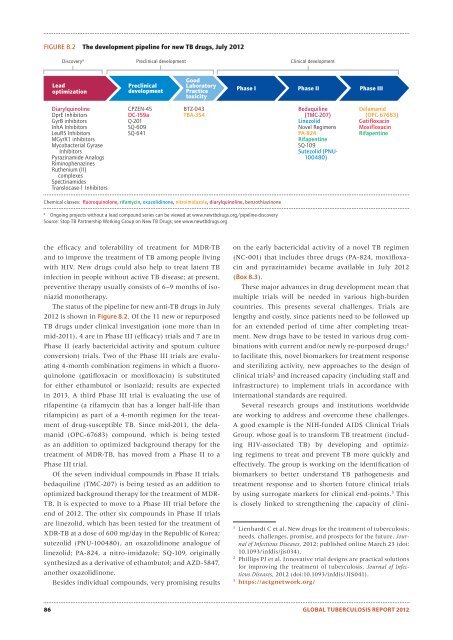Global Tuberculosis Report -- 2012.pdf
Global Tuberculosis Report -- 2012.pdf
Global Tuberculosis Report -- 2012.pdf
Create successful ePaper yourself
Turn your PDF publications into a flip-book with our unique Google optimized e-Paper software.
FIGURE 8.2 The development pipeline for new TB drugs, July 2012Discovery a Preclinical development Clinical developmentLeadoptimizationPreclinicaldevelopmentGoodLaboratoryPracticetoxicityPhase I Phase II Phase IIIDiarylquinolineDprE InhibitorsGyrB inhibitorsInhA InhibitorsLeuRS InhibitorsMGyrX1 inhibitorsMycobacterial GyraseInhibitorsPyrazinamide AnalogsRiminophenazinesRuthenium (II)complexesSpectinamidesTranslocase-1 InhibitorsCPZEN-45DC-159aQ-201SQ-609SQ-641BTZ-043TBA-354Bedaquiline(TMC-207)LinezolidNovel RegimensPA-824RifapentineSQ-109Sutezolid (PNU-100480)Delamanid(OPC-67683)GatifloxacinMoxifloxacinRifapentineChemical classes: fluoroquinolone, rifamycin, oxazolidinone, nitroimidazole, diarylquinoline, benzothiazinoneaOngoing projects without a lead compound series can be viewed at www.newtbdrugs.org/pipeline-discoverySource: Stop TB Partnership Working Group on New TB Drugs; see www.newtbdrugs.orgthe efficacy and tolerability of treatment for MDR-TBand to improve the treatment of TB among people livingwith HIV. New drugs could also help to treat latent TBinfection in people without active TB disease; at present,preventive therapy usually consists of 6–9 months of isoniazidmonotherapy.The status of the pipeline for new anti-TB drugs in July2012 is shown in Figure 8.2. Of the 11 new or repurposedTB drugs under clinical investigation (one more than inmid-2011), 4 are in Phase III (efficacy) trials and 7 are inPhase II (early bactericidal activity and sputum cultureconversion) trials. Two of the Phase III trials are evaluating4-month combination regimens in which a fluoroquinolone(gatifloxacin or moxifloxacin) is substitutedfor either ethambutol or isoniazid; results are expectedin 2013. A third Phase III trial is evaluating the use ofrifapentine (a rifamycin that has a longer half-life thanrifampicin) as part of a 4-month regimen for the treatmentof drug-susceptible TB. Since mid-2011, the delamanid(OPC-67683) compound, which is being testedas an addition to optimized background therapy for thetreatment of MDR-TB, has moved from a Phase II to aPhase III trial.Of the seven individual compounds in Phase II trials,bedaquiline (TMC-207) is being tested as an addition tooptimized background therapy for the treatment of MDR-TB. It is expected to move to a Phase III trial before theend of 2012. The other six compounds in Phase II trialsare linezolid, which has been tested for the treatment ofXDR-TB at a dose of 600 mg/day in the Republic of Korea;sutezolid (PNU-100480), an oxazolidinone analogue oflinezolid; PA-824, a nitro-imidazole; SQ-109, originallysynthesized as a derivative of ethambutol; and AZD-5847,another oxazolidinone.Besides individual compounds, very promising resultson the early bactericidal activity of a novel TB regimen(NC-001) that includes three drugs (PA-824, moxifloxacinand pyrazinamide) became available in July 2012(Box 8.3).These major advances in drug development mean thatmultiple trials will be needed in various high-burdencountries. This presents several challenges. Trials arelengthy and costly, since patients need to be followed upfor an extended period of time after completing treatment.New drugs have to be tested in various drug combinationswith current and/or newly re-purposed drugs; 1to facilitate this, novel biomarkers for treatment responseand sterilizing activity, new approaches to the design ofclinical trials 2 and increased capacity (including staff andinfrastructure) to implement trials in accordance withinternational standards are required.Several research groups and institutions worldwideare working to address and overcome these challenges.A good example is the NIH-funded AIDS Clinical TrialsGroup, whose goal is to transform TB treatment (includingHIV-associated TB) by developing and optimizingregimens to treat and prevent TB more quickly andeffectively. The group is working on the identification ofbiomarkers to better understand TB pathogenesis andtreatment response and to shorten future clinical trialsby using surrogate markers for clinical end-points. 3 Thisis closely linked to strengthening the capacity of clini-1Lienhardt C et al. New drugs for the treatment of tuberculosis:needs, challenges, promise, and prospects for the future. Journalof Infectious Diseases, 2012; published online March 23 (doi:10.1093/infdis/jis034).2Phillips PJ et al. Innovative trial designs are practical solutionsfor improving the treatment of tuberculosis. Journal of InfectiousDiseases, 2012 (doi:10.1093/infdis/JIS041).3https://actgnetwork.org/86 GLOBAL TUBERCULOSIS REPORT 2012
















